A question as old as time, Ants vs. Termites – Who Would Win?
Never before has anyone gone characteristic by characteristic to find the answers – but that changes today.
We are excited to bring you an epic battle between two of the most annoying insects on the planet.
In one corner, we have ants, a heavy lifter and long-liver with a reputation for being one of the most successful breeding insects in the world.
And standing against him, we have termites, notorious for their lightning-fast bite and incredible endurance.
Throughout this article, we’ll explore each of these insects’ various strengths and weaknesses, including their size, strength, special gear, endurance, poison, and power.
Who will come out on top? Let’s find out!
The Ant
Despite their small size, Ants are among the strongest animals on the planet.
They have been around for over a hundred million years and are famous for being one of the most successful heavy lifters in the world.
Only a few incredible animals, like the dung beetle, are stronger (but ants are cooler).
If a regular human had ant-size lifting abilities, they could easily lift to 7000 pounds, like half an elephant or your neighbor’s pickup truck.
Ants also live forever and hold the world’s lifespan record among insects. These tiny guys can live up to 30 years and don’t really care where they live. Spanning nearly every continent but Antarctica.
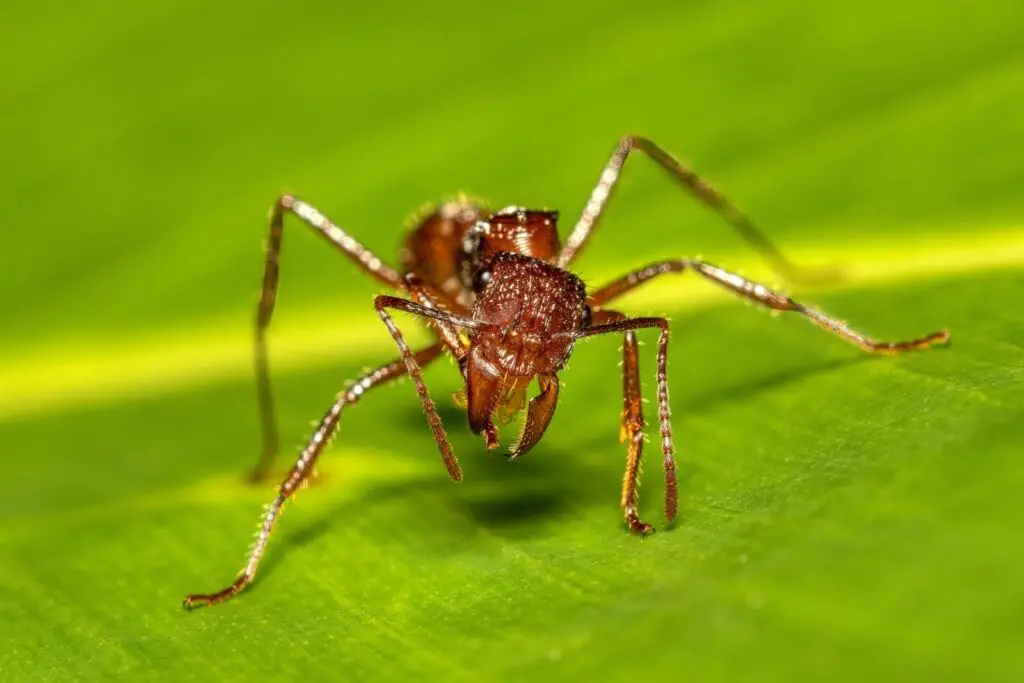
The Termite
Termites are tiny insects that love to sneak into your house undetected by biting through wood, paper, and other materials.
They aren’t really interested in interacting with people, though; all they need is food, and either fresh grass or your brand-new barn will do just fine.
There are way more termites than people in the world. If you got every human and termite together, the termites would outweigh the humans.
Termites hold the record for being one of the world’s fastest animals. They don’t run fast but can clap down their jaws faster than almost anyone.
In a head-to-head match, ants and termites have different strengths and weaknesses. While ants are smaller and more aggressive, termites have impressive endurance and can squirt acid from their head tubes. Overall, it’s a close match; the winner is anyone’s guess.
Let’s dive a little deeper.
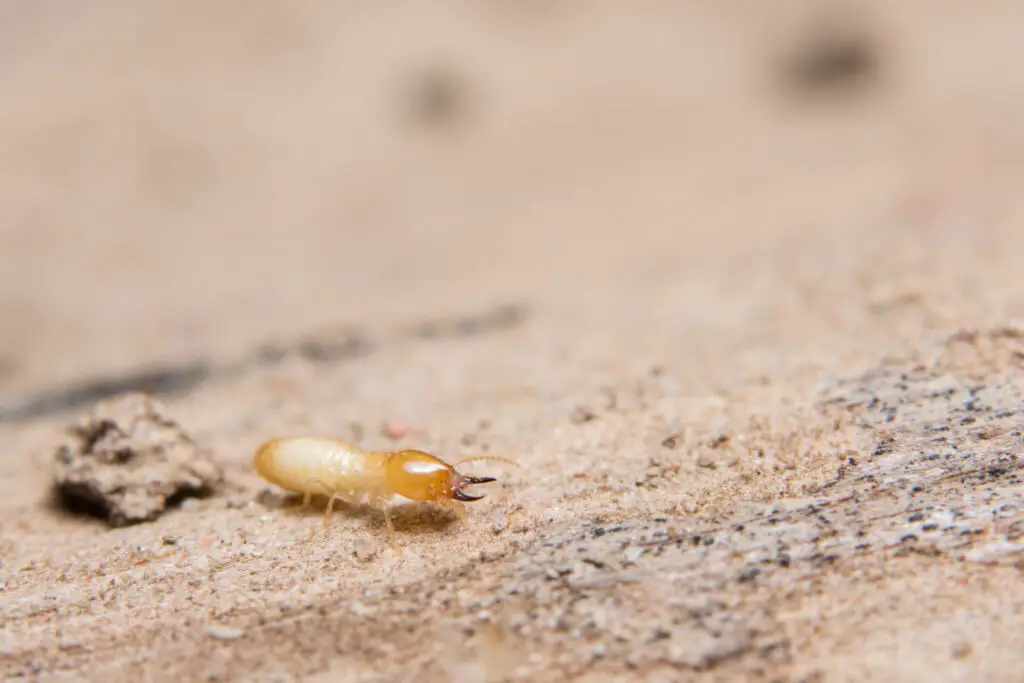
Category One: Size and Strength
First, we’re going to take a look at the size of both ants and termites. While both insects come in various sizes, ants are, on average smaller than termites.
Ants weigh around 5 milligrams and can range from 2 to 12 millimeters in length. A known secret in the Ant-Keeping community is the Queen ant is by far the biggest ant of each different ant species. This makes sense, since she makes the rules, she’ll need the size to enforce them.
Ants, while a pest, are known for being one of the most successful heavy lifters in the world, able to carry up to 55 times their weight.
If a regular human had ant-sized lifting abilities, they could easily lift 6,500 pounds, which would be enough to pick up a light helicopter (Source)
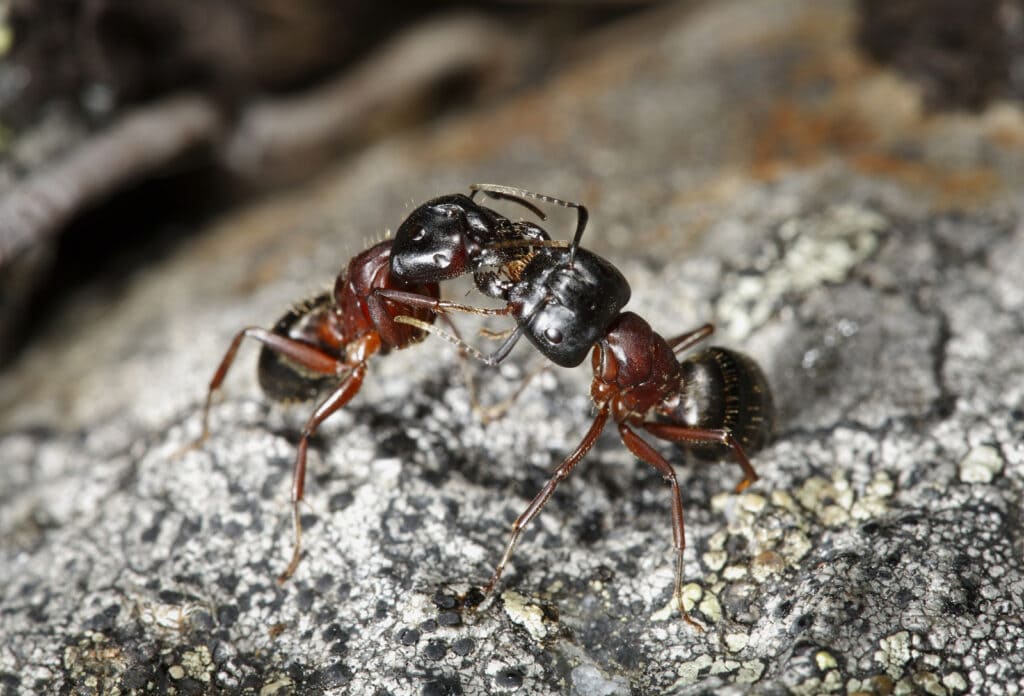
Termites, on the other hand, are generally larger than ants. While the smallest termite is still larger than the largest ant, a single ant could easily out-lift a termite any day. But don’t start to think they are weak.
A nest of termites can easily weigh up to a thousand pounds, quickly prodding and picking apart any resources these predators choose.
Despite the fact that the smallest termite is bigger than the largest ant, a single ant could easily take on a termite any day.
Ants tend to be much more aggressive and usually roll in a big group (ant colonies), leading to devastating ant attacks.
In this round, the ants take the lead, and the score is 1-0.
Category Two: Equipment
Here will take a look at the equipment that both insects possess.
While ants tend to act like wasps and use their sting to defend themselves, termites don’t have any special gear to protect themselves.
During the battle, even if the ant decides not to sting, the bite might still hurt just as bad. Some ants bite so hard that it can feel like walking on burning coals.
For example, the bullet ant has been seen to be one of the most devastating bites in the world. (Source)
Don’t count termites out yet, Termites have tubes on their head that can squirt acid, which for an insect is a very unique feature.
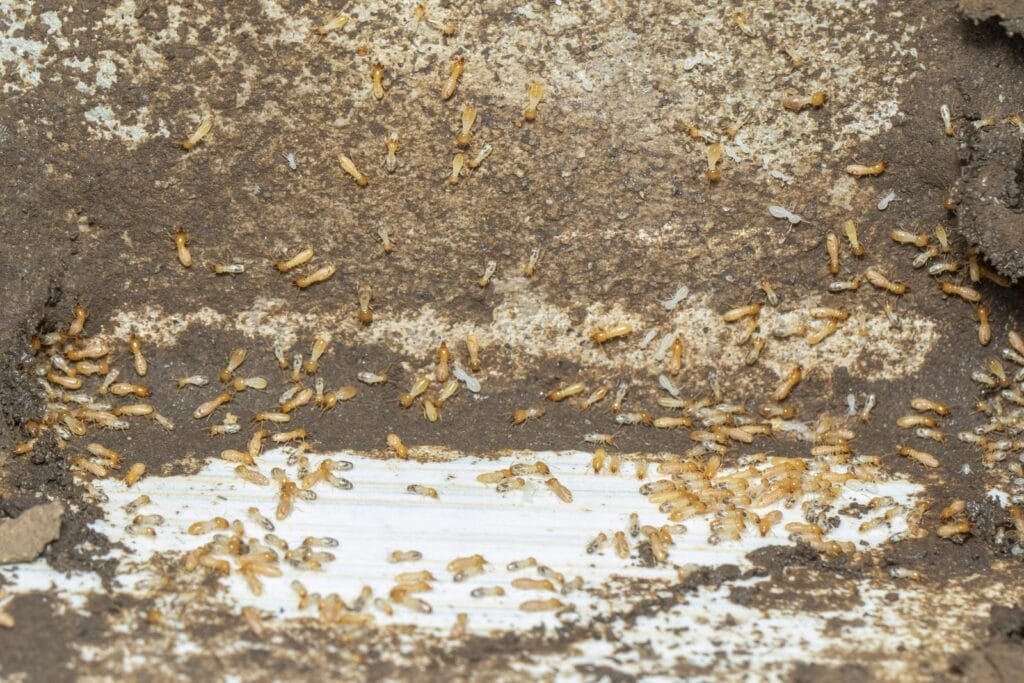
During the battle, the ants can gear up for a sting or a bite all they want, but they’ll never get close enough to the termite species because of those tubes.
However, if it did happen, and the ants could spray some acid onto the termites (Source), they would win in a battle.
While the battle between termites and ants is still close, termites take the point here, as termite colonies are loaded with special equipment that would help them in an intense battle.
Category Three: Endurance
We can see that both competitors are starting to show signs of fatigue.
Our Ants are slowing down and appear to need a quick nap (Source) while the termite shows no signs of slowing down and continues to slowly little down the ants.
It’s clear that termites have incredible endurance, as they never need to sleep and only crave food 24/7. (Source)
In contrast, ants may be one of the most successful heavy lifters in the world, but they do get tired and require rest.
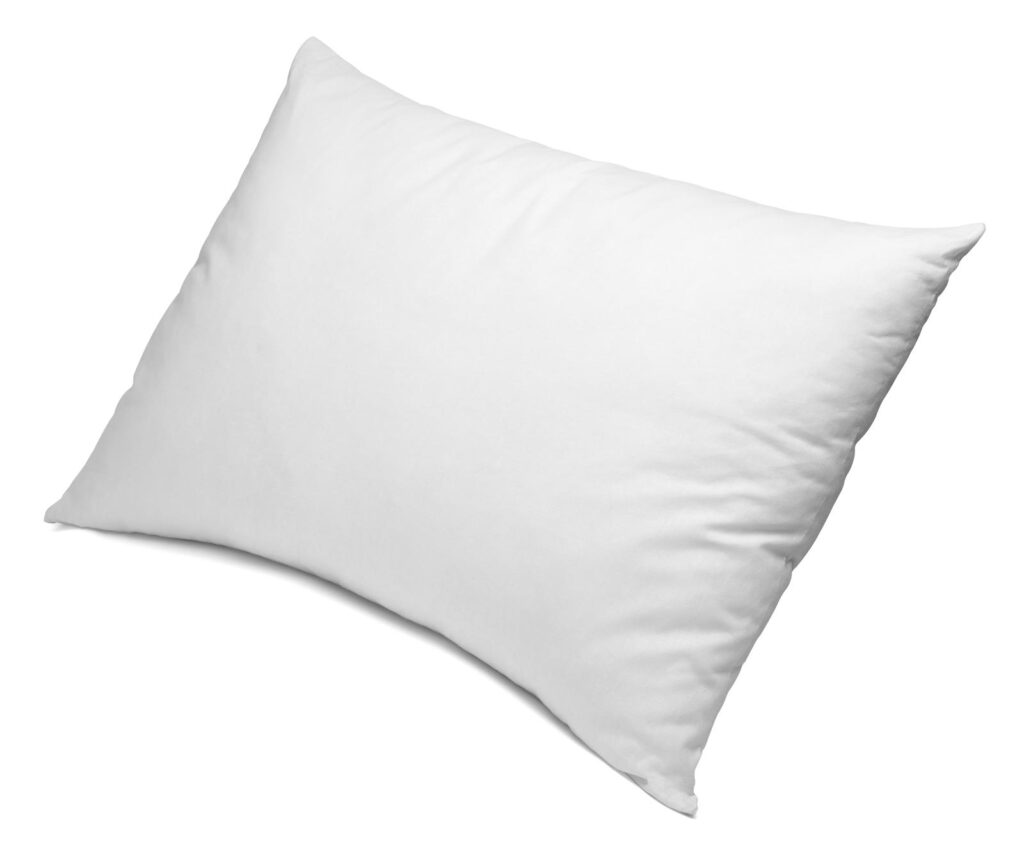
While endurance is usually seen in the short term, realize that ants are survivors, and they don’t give up easily.
In fact, they have one of the most extended lifespans among insects, living up to 30 years.
Even with the life-span advantage here, never having to sleep to sleep gives the termites the 2-1 lead here over the ants.
Category Four: Raw Power And Aggression
Both of these insects are known for their strength and unique abilities.
The ant, one of the most successful heavy lifters in the world, can carry up to 60 times its weight.
On the other hand, termites are known for their ability to sneak into houses undetected and chew through wood and paper.
They are also speedy creatures and hold the record for being one of the world’s fastest animals.
A single termite may not be as strong as an ant, but a whole colony of termites in one termite mount can easily surpass thousands of pounds.
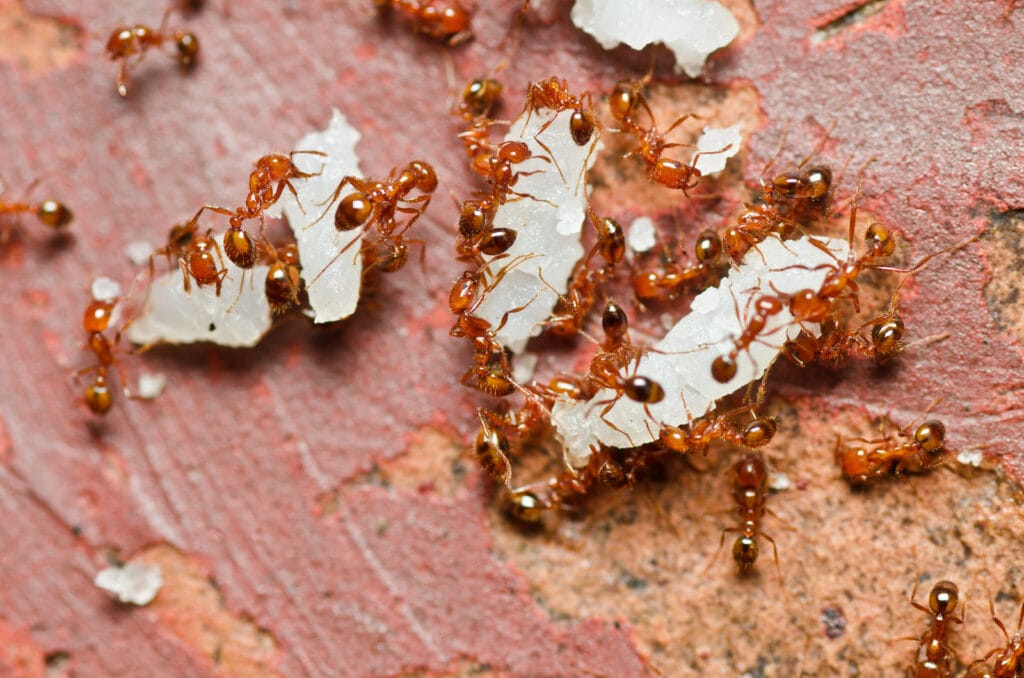
While ants are more aggressive and usually roll in a big group, termites have tubes on their head that can squirt acid.
What good is aggression if you’re unable to get close to your enemy?
Despite this, Ants wouldn’t give up.
Ants are known for pursuing bigger and faster creatures, sacrificing worker ants while navigating a region’s terrain to slowly whittle down their opponent.
While ants are more powerful and more aggressive, it may not be enough to overcome the speed of the termite. And while ants usually have the numbers advantage in a raid – it may not be as strong here.
Both get a point here, moving the score 3-2, in favor of the termites.
Category Five: Toughness
Both insects have unique features that make them formidable opponents, but who is tougher?
Ants leverage their strong exoskeleton to protect themselves from danger and sacrifice members of their colony for the greater good.
Let’s dive into a few aspects such as survival strategy, societal structure, and adaptability.
This is where ants might have a slight edge over their termite counterparts.
Ants are known for their adaptive skills, being able to survive in various landscapes – literally existing in every continent (but one) and in every single type of terrain – from rainforests to deserts.
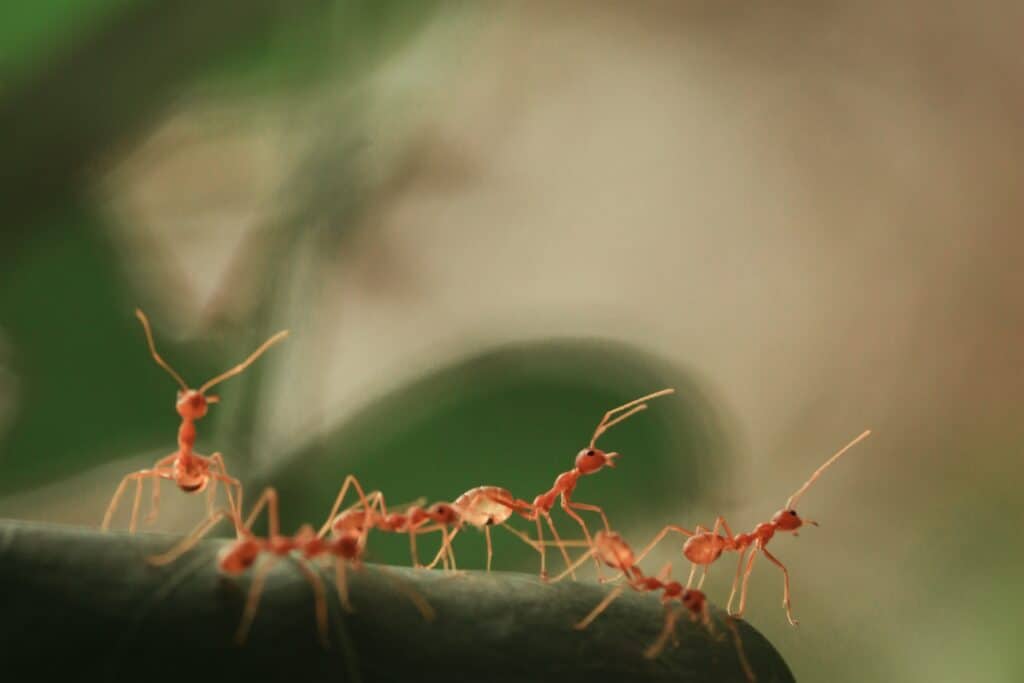
Their highly structured and organized social system, coupled with their ability to efficiently harvest and store food, makes them a mighty pest.
While termites also deserve praise for their sophisticated societal structures and endurance, they tend to be less adaptive to varied environments, and their dependence on a specific type of food (wood or cellulose) also exposes them to certain vulnerabilities.
With the ability to fight and survive in nearly any environment, the resilience of ants earns them the point in the toughness category – finalizing the score at 3-3.
Final Thoughts: Who Would Win, The Ant Or The Termite?
In this intense battle between ants and termites, both insects showed off their unique strengths and abilities.
While ants are known for their incredible lifting abilities and long lifespan, termites hold the record for being one of the world’s fastest animals and are crucial for improving crop growth.
Throughout the battle, we saw both ants and termites showcase their size, strength, equipment, endurance, and toughness.
While ants proved to be more aggressive and had the advantage in strength, termites showed off their incredible endurance and their cool ability to squirt acid from their head tubes.
Ultimately, the battle resulted in a tie, leaving us with more questions than answers.
Both insects proved tough and resilient, showcasing their survival skills in the wild. As we witnessed in this battle, ants and termites may be small, but they are mighty and play a crucial role in our ecosystem – and we wouldn’t be here without them.

Frequently Asked Questions
A more serious tone to answer some of the questions our readers have had
What are the main differences in the colony structure between ants and termites?
The main difference is that ants have a strict hierarchical structure in their colony: there’s a queen, males, and different types of workers. On the other hand, a termite colony also has a queen and king, but the rest of the members are divided into soldiers and workers, without the presence of sub-classes. This is a primary reason why ants would systematically tackle each termite class, which could offer them an advantage.
Who is a more invasive pest, ants or termites, and why?
Both ants and termites can be considered pests. However, termites tend to cause more significant structural damage to human-made structures due to their wood-eating habits. Argentine ant and fire ant colonies can be more destructive and aggressive than termites, yet the impact they have on structures is far less severe than that of an equal termite population.
Do ants ever eat termites, or is there a specific reason to attack ants?
Certain species of ants, like the Matabele ants or the fire ants, do prey on termites. They attack termite mounds in search of food, carrying the termites as food sources back to the nest. The reason why ants target termites could be attributed to their nutritive value, they are a good source of protein and are easily accessible due to the size and weight difference.
Are there any species of ants or termites that pose more of a threat as pests than others?
Different species pose different levels of threats. The Argentine ant and the fire ant, for instance, are known as quite invasive and aggressive species. Among termites, subterranean termites are considered the most destructive, as they can cause considerable damage to human-made structures.
In a hypothetical battle between ants vs. termites, who would win?
This is subjective and would depend on the specific species involved. Matabele ants, for instance, are known to attack and bring down termite mounds effectively. However, each species has its unique sets of abilities that could tilt the result of a battle in their favor.
Does pest control have a different method of handling ants and termites?
Pest control methods are often specially tailored for the type of pest. Ants can usually be controlled using baits and pesticides, while termites require more specialized treatment methods, including termite insecticides and barrier treatments.

